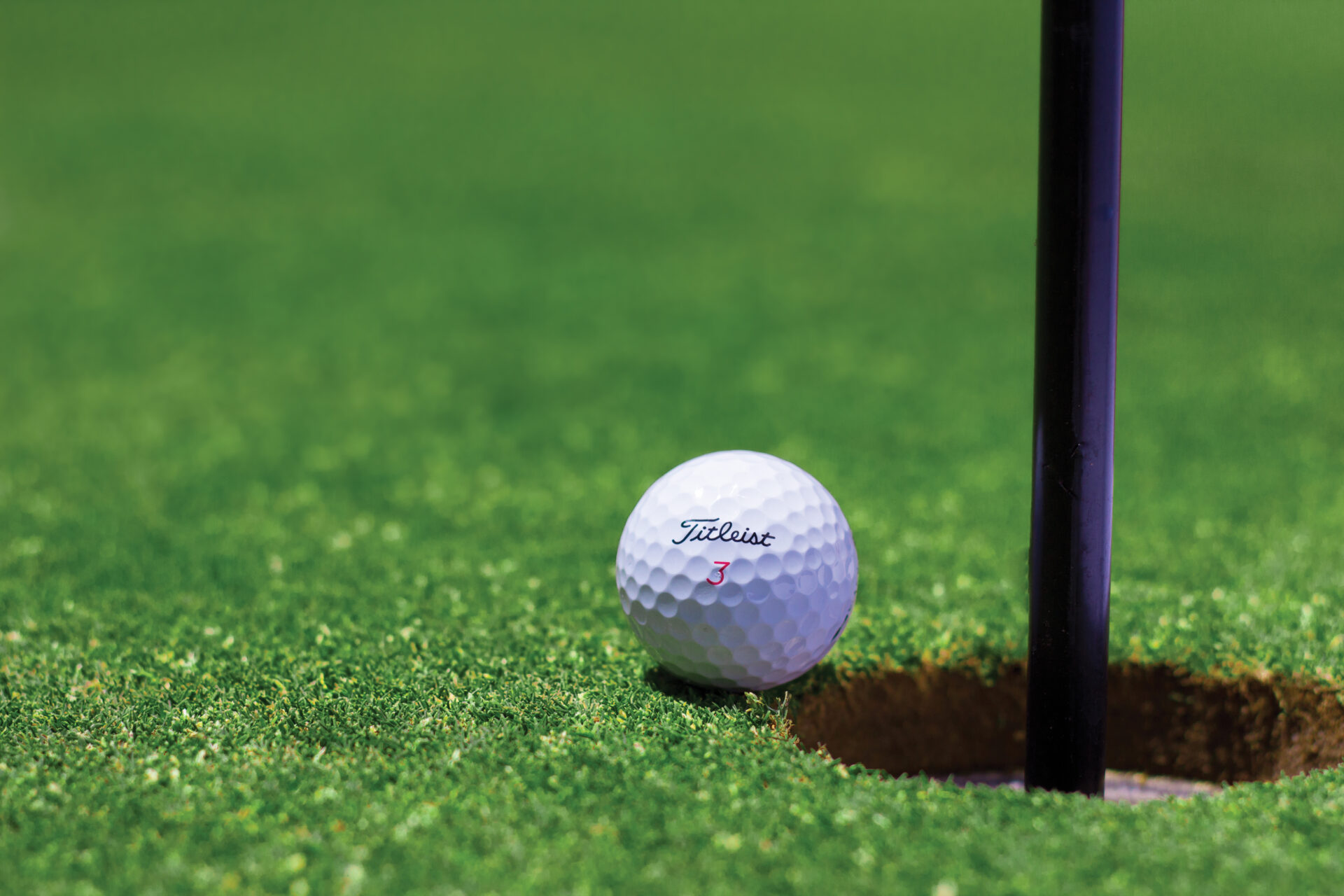Golf is a sport that’s been around for centuries and while the rules and equipment have changed over time, one of the most essential pieces of equipment remains the same – the golf ball. While it may seem like a simple object on the surface, there is actually quite a bit of technology and design that goes into manufacturing a golf ball. In this article, we’ll take a look at what’s inside a golf ball and how it helps players achieve their best game.The inside of a golf ball is made up of several layers. These layers typically include a core, one or more rubber-like ionomer layers, and a cover. The core is typically made of solid rubber and helps to determine the distance and trajectory of the ball when hit. The rubber-like ionomer layers provide resiliency and control the spin of the ball. The cover is usually made from urethane or Surlyn which helps protect the inner layers and provides additional spin for shots around the green.
How Are Golf Balls Constructed?
Golf balls are constructed from a variety of materials including rubber, plastic, and other synthetic substances. The core of the golf ball is typically made of rubber or plastic, while the outer layer is made from a harder material such as surlyn or balata. The cover of the ball can vary in thickness depending on its intended use and performance characteristics. For example, softer covers allow for more spin, while harder covers offer extra distance.
The core of the golf ball is encased in multiple layers of either rubber or plastic, each with its own specific purpose. The innermost layer generally provides compression which helps to create a softer feel when striking the ball. The middle layer usually provides durability and a solid layer for the outer cover to adhere to. The outermost layers are designed to provide spin control and improved distance when struck correctly.
The dimple pattern on a golf ball is important for achieving maximum distance and accuracy when shot off the tee box. Dimples reduce drag by creating tiny pockets of air that help keep the ball aloft longer during flight and also aid with spin control when hitting into greens or fairways. Dimple patterns can vary greatly depending on their intended design characteristics such as high launch angle or low trajectory shots.
Golf balls have come a long way since their invention over 200 years ago and modern technology has allowed manufactures to develop new materials that improve performance and accuracy on the course. With advancements in technology, golfers now have an array of different types of golf balls available to them in order to find one that fits their game perfectly.
What Materials Are Used in Golf Balls?
Golf balls are composed of several different materials, which vary depending on the type of golf ball. The core of a golf ball is typically made from either a solid rubber or liquid-filled center. This center is surrounded by a layer of compression-molded rubber, which gives the ball its compression and allows it to react to the club head. The outer layers of most golf balls are made from a durable and resilient material like urethane or balata. Urethane golf balls provide more spin and control, while balata golf balls are softer and provide more feel. Additionally, some manufacturers use proprietary materials for their golf ball covers to give them distinct characteristics that set them apart from other brands. Lastly, dimples help with aerodynamics, helping the ball fly farther and straighter.
Overall, golf balls are made up of many different materials to provide optimal performance for various types of players. Knowing what materials make up your golf ball can help you select one that best suits your game.
What Is the Core of a Golf Ball Made Of?
The core of a golf ball is the innermost component and typically made from rubber or plastic. The type of material used for the core affects the overall performance of a golf ball, so manufacturers strive to find the perfect mix of materials. Modern golf balls typically have two-piece cores made from rubber, plastic, or a combination of both. The innermost layer is usually an elastomer, such as Surlyn or polybutadiene. This helps to create an optimal compression that maximizes distance and spin control when hit with a golf club. This layer is then encased in an outer-layer made from either Surlyn or a combination of Surlyn and polybutadiene. The outer layer provides additional protection for the inner core and helps to maintain its shape when hit with a club.
In addition to the two-piece core construction, some golf balls are designed with three-piece cores that feature an additional center layer known as a “mantle” composed of either urethane or polyurethane. This mantle helps to increase spin rate and accuracy when making shots around the green since it has more grip than traditional rubber cores. Three-piece cores also help to keep driver shots straight since they offer less compression than their two-piece counterparts.
No matter what type of material is used for a golf ball’s core, its construction plays an integral role in determining how far and accurately it will travel when struck with a club. As such, it’s important to understand what type of core your ball has before selecting one for your game.
What Is the Cover of a Golf Ball Made Of?
The cover of a golf ball is typically made from Surlyn, a thermoplastic material that is durable and resistant to cuts and abrasions. This material provides excellent spin control for players, making it easier to control the ball in the air. The core of a golf ball is usually composed of rubber or synthetic materials, which helps to create the proper spin on the ball. The dimples on the surface of the golf ball also help with aerodynamics, making it easier to hit shots at longer distances. The construction of golf balls has changed over time, as manufacturers have experimented with different materials and designs to create better performing balls.

Urethane and Surlyn Covers
Urethane and Surlyn covers are two of the most popular materials used for golf ball covers. Urethane is a synthetic rubber-like material which is soft and durable. It provides excellent spin control and is very popular for golfers seeking more accuracy in their shots. Surlyn, on the other hand, is a polymeric resin material that has excellent durability and provides great distance to shots. The difference between the two materials lies in how they interact with the club face upon impact. Urethane generates more spin than Surlyn due to its softer nature, which gives it better control over the ball’s trajectory. Surlyn, on the other hand, produces less spin but offers increased distance due to its harder surface which does not deform as much when it comes into contact with the clubface. Both materials have their advantages and disadvantages depending on what type of golfer you are, so it is important to choose wisely when selecting your golf ball cover material.
In terms of cost, Urethane tends to be more expensive than Surlyn because of its superior performance characteristics. It also requires more maintenance than Surlyn as it will need to be replaced more frequently due to its softer nature. On the other hand, Surlyn is less expensive and generally lasts longer than Urethane as it does not need to be replaced as often since its hard surface resists deformation better than Urethane’s softer one does upon impact with a clubface.
Overall, both Urethane and Surlyn covers have their own unique advantages depending on what type of golfer you are looking for performance from your golf ball cover material. If you are a player who seeks accuracy in your shots then Urethane may be your best bet while players seeking distance may find that Surlyn offers them better performance in this regard due to its hard surface that resists deformation upon impact with a clubface better than Urethane’s softer one does.
Different Types of Golf Balls Have Different Interiors
Golf balls come in many different varieties, and each type has its own unique interior design. For example, some golf balls have a solid core surrounded by a high-compression rubber or plastic cover. This type of golf ball is designed to generate maximum distance off the tee, as the core gives the ball spin and control while the cover provides durability. Other golf balls have a solid core with multiple layers of rubber or plastic surrounding it. These multi-layer golf balls are designed for more spin and control around the greens, giving players greater accuracy and stopping power when hitting approach shots.
Golf balls also come in different sizes and weights, and each size or weight has an effect on the interior design. Heavier golf balls tend to have a firmer feel and provide more distance due to their increased mass. Lighter golf balls are made with softer materials that provide more spin and control around the greens, but they don’t travel as far off the tee. Similarly, larger golf balls tend to fly farther than smaller ones due to their larger surface area which allows them to catch more air when hit.
Finally, there are various materials used in the construction of a modern golf ball’s interior design. The most common materials include rubber, plastic, urethane, titanium cores, and even liquid centers which give the ball extra feel around the greens. Each material has its own benefits and drawbacks when it comes to performance on the course – it’s up to players to decide what type of ball best suits their game.
How Does the Inner Construction of a Golf Ball Affect Performance?
The inner construction of a golf ball is key to its performance. A golf ball is made up of several layers that all work together to produce the desired result. The inner core is the most important part of a golf ball, as it provides the majority of the ball’s energy and spin. The cover material affects how much spin and distance can be achieved, as well as how it reacts with the club face. The dimples on the surface of the golf ball help to reduce drag, allowing for increased distance and accuracy.
The core material of a golf ball impacts its performance more than any other factor. The core material affects how quickly it compresses when it is hit, which in turn determines how much energy is transferred from the club head and how far the shot will travel. Different materials can also affect spin rate, trajectory, and accuracy. Some manufacturers use multiple layers in their cores to provide additional control over these factors.
The cover material also plays an important role in how a golf ball performs. Soft covers tend to provide more spin but sacrifice some distance due to increased drag, while harder covers create less spin but offer greater distance due to reduced drag. Covers are usually made from urethane or balata, with each having its own set of advantages and disadvantages depending on individual needs.
Finally, dimples on a golf ball’s surface can affect both accuracy and distance. Dimples create turbulence in the air around the ball which helps reduce drag and increase lift, thus allowing for longer shots with more control over direction. Dimple patterns vary between brands and models but generally have between 300-500 dimples per ball that are designed to optimize performance in different conditions such as windy environments or wet surfaces.
In conclusion, understanding how each component within a golf ball affects performance can help players choose the best option for their playing style and conditions they are playing under. With so many options available on today’s market it is important for players to select a model that will perform best for them based on their needs and preferences.

Conclusion
A golf ball is a complex piece of engineering that requires a lot of research and development to get the most out of it. The inner core, cover, dimples, and spin-layers all have an important role to play in how the ball performs. There are many factors that affect how well a golf ball will fly and roll, so it is important to understand what is inside a golf ball in order to make sure you are getting the most out of your game. With all the different materials and components involved in making a golf ball, it is easy to see why they play such an important role in the sport.
Golfers can benefit from having an understanding of what is inside a golf ball in order to select one that fits their game. From core materials and weight, to cover types and dimple patterns, there are many options available when it comes time to choose the right golf ball for your game. With this knowledge, golfers can make informed decisions about which type of ball will best suit their needs and help them perform at their highest level on the course.




